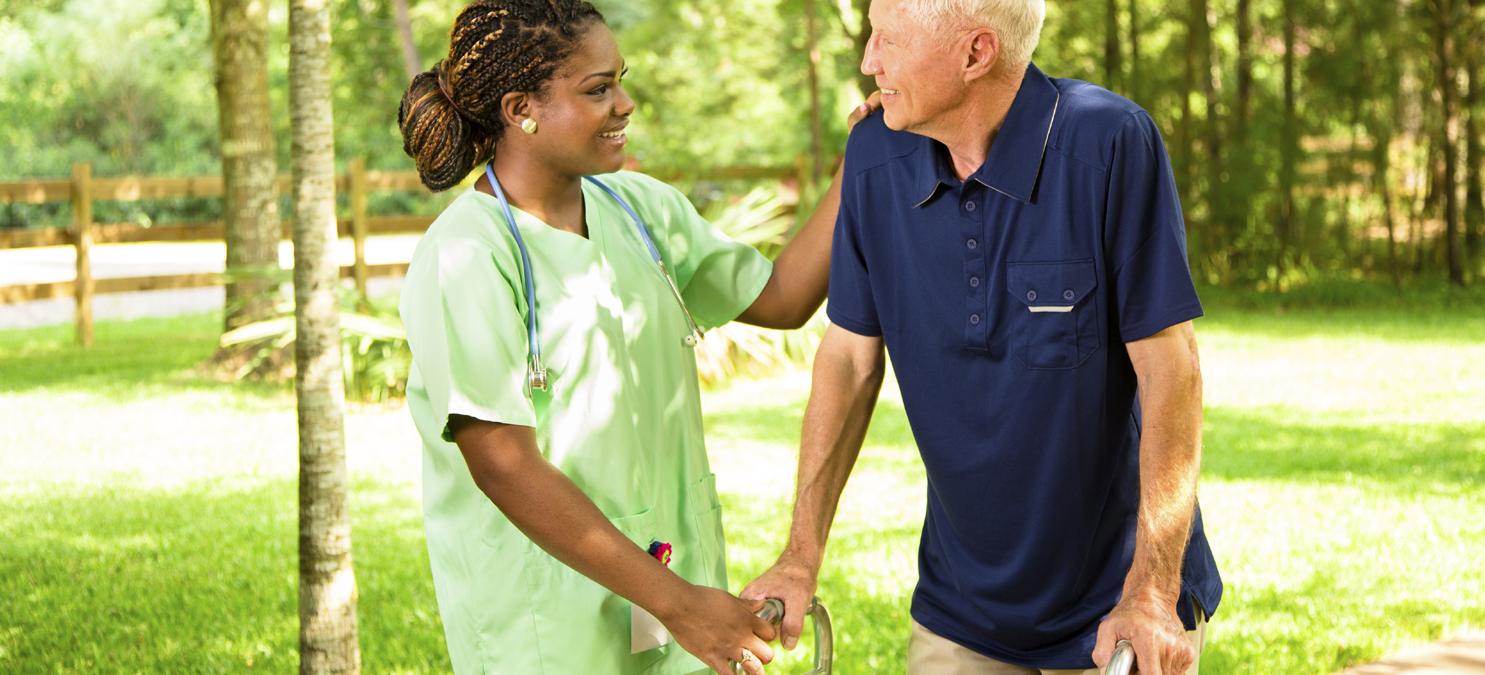What Do Home Health Aides Do?
Home health aides work in the homes of people who need assistance in caring for themselves. They often help people who are disabled, chronically ill, or cognitively impaired. They also help older adults who may need assistance or people recovering from an illness who may live alone or need more assistance than their families can provide. Home health aides usually work under the supervision of a registered nurse or other health care practitioner to provide basic patient care. Home health aides may take and record a patient’s temperature, pulse, and blood pressure; assist patients with activities of daily living, such as feeding, bathing, dressing, and toileting; help patients to get in and out of bed; and assist with nursing procedures. Home health aides may also observe and report on patients’ physical, mental, and emotional states to their supervisor. In addition, they may assist with shopping, meal preparation, and housekeeping. Although their work can be physically and emotionally demanding, many home health aides gain great satisfaction from assisting those in need.
For more information: http://www.bls.gov/ooh/healthcare/home-health-aides.htm
Where Do Home Health Aides Work?
Home health aides are usually employed by home health agencies and work in patients’ homes. Home health aides often visit multiple patients on the same day. Some home health aides work in small group homes or larger care communities.
Most full-time aides work about 40 hours per week, but because patients need care 24 hours a day, some aides may work evenings, nights, weekends, and holidays.
What Do Home Health Aides Earn?
In 2022, the average annual income reported by the Bureau of Labor Statistics (BLS) for home health and personal care aides in the United States was $30,903. The New York State Department of Labor (NYSDOL) reports that, in 2023, home health and personal care aides in New York earned a median annual salary of $35,191 (home health and personal care aides in the 25th percentile made approximately $33,696 while those in the 75th percentile made approximately $39,833).
Supply and Demand
The Bureau of Labor Statistics projects that the number of jobs for home health and personal care aides in the U.S. will increase by 25% between 2021 and 2031. The New York State Department of Labor projects that the number of jobs for home health and personal care aides in the state will increase by 39% between 2020 and 2030.
Demand for Home Health Aides is growing significantly, attributable in part to the aging of the country’s population. Elderly and disabled clients increasingly rely on home care as a less expensive alternative to nursing homes or hospitals. Clients who need help with everyday tasks and household chores, rather than medical care, can reduce their medical expenses by living in their homes and receiving medical care from a Home Health Aide. Another reason for a high demand for home care is that most clients prefer to be cared for in their homes where they are most comfortable. Studies have found that home treatment is often more effective than care in a nursing home or hospital, prolonging life, and increasing quality of life.
For more information on projections of home health aides by New York State labor regions, 2018-2028, please click here.
New York Education and Licensure Requirements
Most home health and personal care aide have a high school diploma. Home health aides in New York must complete a 75-hour Department of Health training program. These training programs are available in a variety of settings, including high schools typically working through a Board of Cooperative Educational Services (BOCES), vocational-technical schools, nursing care facilities, community colleges, and some home health agencies. Training program topics include communication and documentation skills; reading and recording vital signs; basic infection control procedures; body mechanics; maintenance of a healthy environment; emergency procedures; physical, emotional, and developmental characteristics of patients; personal hygiene and grooming; safe patient transfer techniques; normal range of motion and positioning; and healthy nutrition.
Most home health aides also receive training on-the-job by registered nurses, supervisors, or other health care providers in tasks specific to their clients. Aides also learn basic safety techniques and how to respond in an emergency. In addition, home health aides are required to complete 12 hours of in-service training each year.
The National Association for Home Care and Hospice offers certification for home health aides. http://www.nahc.org.
The Federal Government has guidelines for home health aides whose employers receive reimbursement from Medicare. Federal law requires home health aides to pass a competency test covering a wide range of areas. A home health aide may receive training before taking the competency test.
Financial Support
Many home health agencies offer free home health aide training to individuals who agree to work for them on completion of training.
Home Health Aide Education Programs in New York (subject to change)
Home health aides are generally not required to have a high school diploma, although many do. Some employers provide classroom instruction for newly hired aides, while others rely exclusively on informal on-the-job instruction by registered nurses, licensed practical nurses, or experienced aides. Such training may last from several days to a few months. Aides also may attend lectures, workshops, and in-service training. Also, clients may prefer that tasks are done a certain way and may make those suggestions to the home health aide. A competency evaluation may be required to ensure the aide can perform the required tasks.
For the New York State Education Department list of home health aide training programs, click here: http://www.op.nysed.gov/prof/nurse/nurseprogs-hha.htm.
Some Education Programs in New York (Subject to Change)
| Schenectady County Community College Workforce Development & Community Education 433A State St, 2nd Fl Schenectady, NY 12305 (518) 621-4007 |
Corning Community College 1 Academic Dr Corning NY 14830 607-962-9222 |
| Finger Lakes Community College 3325 Marvin Sands Dr Canandaigua, NY 14424 585-394-3522 |
Rochester Educational Opportunity Center 161 Chestnut St Rochester, NY 14604 (585)232-2730 |
| Fulton-Montgomery Community College 2805 State Highway 67 Johnstown, NY 12095 (518) 736-3622 |
Hostos Community College Div of Workforce Dev & Continuing Educ 560 Exterior St Bronx, NY 10451 (718) 518-6656 |
| Lehman College School of Continuing & Professional Studies 250 Bedford Park Blvd W Bronx, NY 10468 (718) 960-8000 |
Westchester Educational Opportunity Program 26 South Broadway Yonkers, NY 10701 (914) 606-7620 |
| SUNY University Center for Academic & Workforce Development ATTAIN System Located in Albany, Binghamton, Bronx, Brooklyn, Buffalo, Long Island, Manhattan, Monticello, Niagara Falls, Ogdensburg, Perry, Queens, Rochester, Staten Island, Syracuse, Watertown, and Westchester |
ASA College Div of Continuing Education Manhattan Campus
1293 Broadway (One Herald Center),
New York, NY 10001
(877) 679-8772
and
Brooklyn Campus
81 Willoughby Street. Brooklyn, NY, 11201 (877) 679-8772 |
Additional Web Links
The Bureau of Labor Statistics: http://www.bls.gov/ooh/healthcare/home-health-aides.htm.
National Association for Home Care and Hospice: www.nahc.org
Healthcare Association of New York: http://www.hanys.org/
The New York State Association of Health Care Providers: http://www.nyshcp.org/
The Paraprofessional Healthcare Institute (PHI): http://phinational.org/
Visiting Nurse Associations of America: www.vnaa.org
[whohit]Home Health Aides[/whohit]

